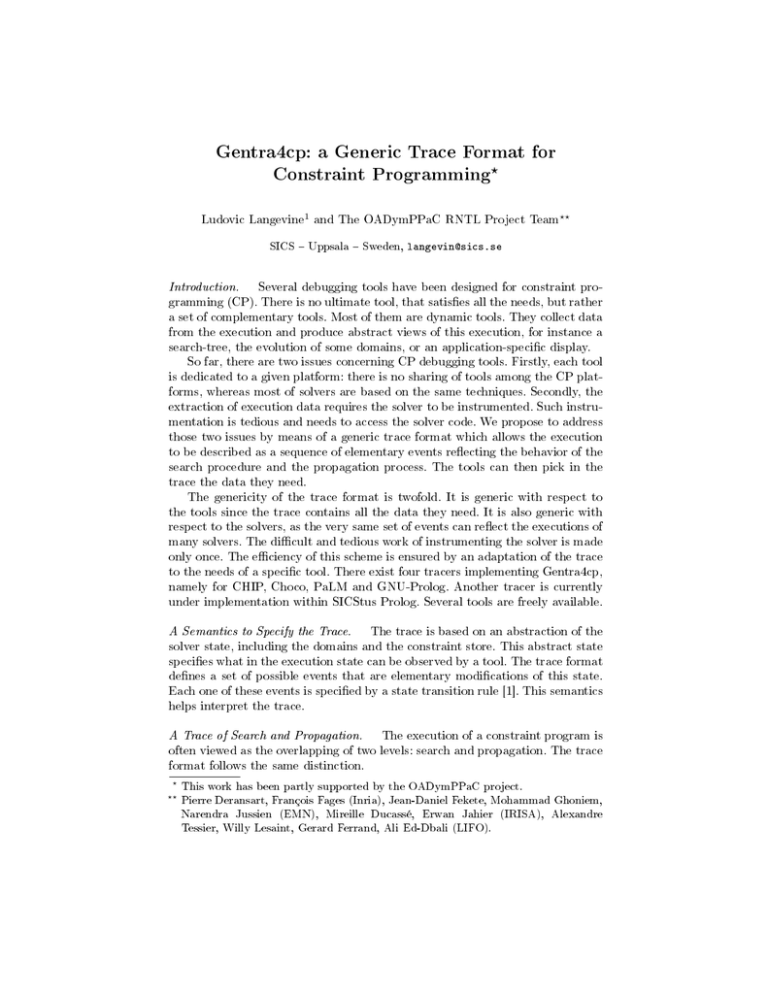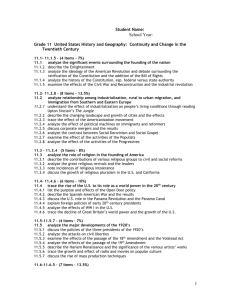Gentra4cp: a Generic Trace Format for Constraint Programming
advertisement

Gentra4cp: a Generic Trace Format for Constraint Programming? Ludovic Langevine1 and The OADymPPaC RNTL Project Team?? SICS Uppsala Sweden, langevin@sics.se Several debugging tools have been designed for constraint programming (CP). There is no ultimate tool, that satises all the needs, but rather a set of complementary tools. Most of them are dynamic tools. They collect data from the execution and produce abstract views of this execution, for instance a search-tree, the evolution of some domains, or an application-specic display. So far, there are two issues concerning CP debugging tools. Firstly, each tool is dedicated to a given platform: there is no sharing of tools among the CP platforms, whereas most of solvers are based on the same techniques. Secondly, the extraction of execution data requires the solver to be instrumented. Such instrumentation is tedious and needs to access the solver code. We propose to address those two issues by means of a generic trace format which allows the execution to be described as a sequence of elementary events reecting the behavior of the search procedure and the propagation process. The tools can then pick in the trace the data they need. The genericity of the trace format is twofold. It is generic with respect to the tools since the trace contains all the data they need. It is also generic with respect to the solvers, as the very same set of events can reect the executions of many solvers. The dicult and tedious work of instrumenting the solver is made only once. The eciency of this scheme is ensured by an adaptation of the trace to the needs of a specic tool. There exist four tracers implementing Gentra4cp, namely for CHIP, Choco, PaLM and GNU-Prolog. Another tracer is currently under implementation within SICStus Prolog. Several tools are freely available. Introduction. The trace is based on an abstraction of the solver state, including the domains and the constraint store. This abstract state species what in the execution state can be observed by a tool. The trace format denes a set of possible events that are elementary modications of this state. Each one of these events is specied by a state transition rule [1]. This semantics helps interpret the trace. A Semantics to Specify the Trace. The execution of a constraint program is often viewed as the overlapping of two levels: search and propagation. The trace format follows the same distinction. A Trace of Search and Propagation. ? ?? This work has been partly supported by the OADymPPaC project. Pierre Deransart, François Fages (Inria), Jean-Daniel Fekete, Mohammad Ghoniem, Narendra Jussien (EMN), Mireille Ducassé, Erwan Jahier (IRISA), Alexandre Tessier, Willy Lesaint, Gerard Ferrand, Ali Ed-Dbali (LIFO). 2 Langevine and the OADymPPaC team The search level is described by 9 dierent events. Firstly, three events deal with the creation of entities (creation of a variable, of a constraint, adding of a constraint into the store). Three specic events are used to trace solutions, failures and choice-points. Most of search-strategies can be modeled as the traversal of a search-tree. The jump-to event aims at tracing the restoration of a former choice-point. The latter four events (solution, failure, choice-point and jumpto) can trace any tree-based search strategy, such as chronological backtracking associated to depth-rst search, branch-and-bound, or dynamic backjumping. Some search strategies cannot be described as a search-tree, for instance repair techniques such as MAC-DBT. Two additional events, relax and restore allow tracing the relaxation of a constraint and an elementary restoration of a domain. It is thus possible to trace a large variety of search strategies [1]. Dierent solvers exhibit dierent propagation strategies (e.g. variable- or constraint-oriented propagation queues, and some priorities). The trace format models the common behaviors while allowing solver specic extensions. Six different events have been dened to trace the propagation process. They capture the common concepts of the solvers we studied. Most of the dierences of these solvers are reected by the order in which those events occur. The reduce event traces an elementary domain reduction. Four events describe the propagation loop: the awakening of a constraint, its suspension, the detection of its entailment or of its unsatisability. Those ve events are generic: they can be found in many constraint solvers, whatever the exact propagation strategy is. The sixth event, schedule, is used to trace solver-specic aspects of the propagation. The trace format is an XML dialect. Since XML is a widely-used standard, an interested developer can choose among dozens of libraries to parse the trace. XML answers the needs of trace structuring thanks to attributes and nested elements: an event is an XML tag that encloses all its attached data. WBXML, a binary representation using a table of symbols, copes with the verbosity of XML and speeds up the parsing of the trace. Easy development of tools thanks to XML. The trace format makes for a potentially very detailed description of the execution. This potential trace is not meant to be exhaustively generated. The format provides a protocol between the debugging tool and the tracer. This protocol is used to set the actual level of details. This level of details can even be modied during the execution. This protocol is exible enough to cope with the versatility of the tools and the evolution of their needs. Trace Content Negotiation. The OADymPPaC project is now nished, but the Gentra4cp format is still under development by instrumentation of new solvers, (e.g. SICStus Prolog). In order to take advantage of these experiences, a new SourceForge project has been set up (see http://tra4cp.sf.net). Evolution of the trace format. References 1. The OADymPPaC Project. Generic trace format for constraint programming. http://contraintes.inria.fr/OADymPPaC/Public/Trace/indexl.html, May 2004.



